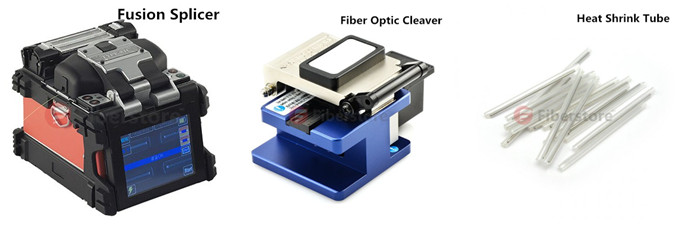Fiber splicing is used to permanently join two optical fibers where no additional changes are expected to be made to those fibers at that juncture. Compared with joints by connectors, fiber splicing typically results in lower light loss and back reflection.
There are two methods of fiber optic splicing: fusion splicing and mechanical splicing. Both of the two are functioning the same. However, they have their own advantages and disadvantages, which should be acknowledged before choosing of the methods of splicing which best fit the economic and performance objectives.
The following text will make a comparison between mechanical splicing and fusion splicing from several aspects (process, time requested, performance and cost) to find the best choice of splicing.
The biggest difference between mechanical splicing and fusion splicing can be figured out by their literally meaning. Mechanical splicing is mechanically joining the fibers ends together which is quick and effective. While fusion splicing is a method of fusing fibers together using arc welding which is fairly complex and requires much more skill than mechanical splicing.
- Step one: strip the protective coatings, jackets, tubes, strength members, etc. leaving only the bare fiber showing.
- Step two: cleave the fiber with a fiber optic cleaver. The cleaved end for fusion splicing must be mirror-smooth and perpendicular to the fiber axis to obtain a proper splice. As to mechanical, the cleaving process is identical to the cleaving for fusion splicing but the cleave precision is not as critical.
- Step three: clean the fiber.
- Step four: after cleaning the fiber, the connecting step starts.
For fusion splicing, fusing fiber contains alignment and heating. Once properly aligned the fusion splicer unit then uses an electrical arc to melt the fibers, permanently welding the two fiber ends together.
Mechanical splicing does not need heating. Simply position the fiber ends together inside the mechanical splice unit. The index matching gel inside the mechanical splice apparatus will help couple the light from one fiber end to the other. - Step five: protect the fiber
Fusion splicing—using heat shrink tubing, silicone gel and/or mechanical crimp protectors will keep the splice protected from outside elements and breakage.
Mechanical splicing—the completed mechanical splice provides its own protection for the splice.

Time Requested: mechanical splicing is fast and effective, which is suitable for some emergency situations. However, fusion splicing is more skilled and need more time to be finished.
Performance: with mechanical splicing, the fibers usually have loss of 0.3dB. However, with fusion splicing, the fibers generally have a loss of 0.1dB and the fiber splices are usually stronger.
Cost:mechanical splicing has a low initial investment ($1,000-$2,000) but costs more per splice ($12-$40 each). While the cost per splice for fusion splicing is lower ($0.50-$1.50 each), the initial investment is much higher ($15,000-$50,000 depending on the accuracy and features of the fusion splicing machine being purchased). The more precise you need the alignment (better alignment results in lower loss) the more you pay for the machine.
Many companies now invest fusion for networks, especially for long haul single-mode networks. However, they also use mechanical splicing for shorter, local cable runs. Consider the requests for performance quality, time, situations and the capacity of economics before choosing the fittest method of splicing.
